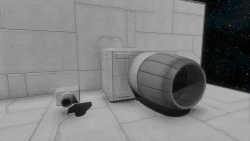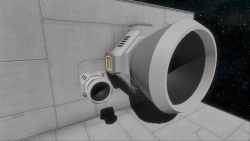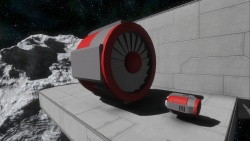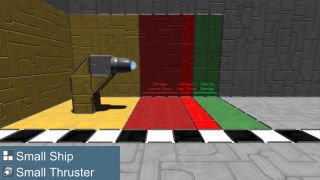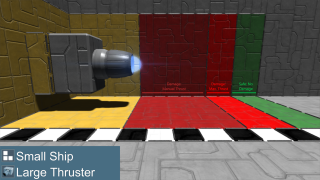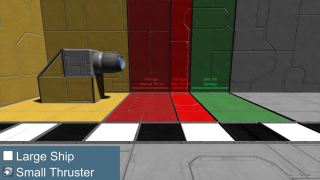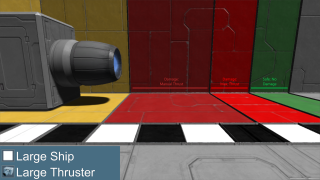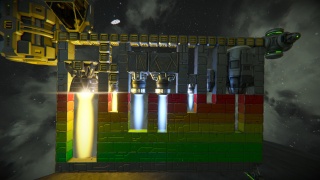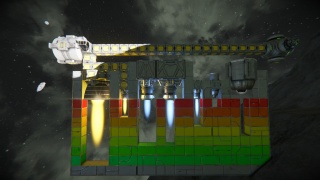推进装置
推进器是所有飞船或者是没有空间锚的空间站移动的主要方式。推进器可以提供飞船一个线性的推力而不会因为所处飞船位置的不同而产生力矩、扭转和旋转(陀螺仪)。只要推进器被连接至了一个整体(而不是异整体或者通过起落架而连接整体),他们都会从整体的质量中心提供推力,因此推进器的摆放位置还是稍有讲究的。游戏中有两种常尺度推进器: 标准推进器,一种使用电力 的离子推进器;氢推,一种使用氢气作为燃料,更为强劲但使用局限也较大的推进器。 在Update 01.105前,推进器有两个模式:常尺度推进和惯性抑制。常尺度推进用于鼠标和键盘操作的人工航行和控制速度(thrust override slider),惯性抑制则会自动额外消耗50%的电力以提供10倍的惯性抑制力。推进器在惯性抑制打开并且飞船仍在凭借惯性前行的情况下会发挥作用并逐渐使船停下。因此在此次更新前,让船停下会比让船加速更为容易。
在01.107更新之前,当惯性减速器(非玩家的操作的反向推力)试图停止飞船时,所有小型船只推进器都将受到5倍的推力而不增加电力或燃料消耗。
Contents
概览
| 方块规格 | 推进装置 | 方块尺寸 (长宽高) |
体积 | 最大 推力 |
重量 | 最大 能耗 |
最大 氢耗 |
推重比 推力vs重量 |
推积比 推力vs体积 |
推能比 推力vs耗能 |
尾焰长 |
|---|---|---|---|---|---|---|---|---|---|---|---|
| |
|
3,3,5 | 703.125 m3 | 6,480 kN | 32,970 kg | 16.8 MW | N/A | 197 N/kg | 9 kN/m3 | 386 kN/MW | 11.23 m |
| |
|
1,1,3 | 46.875 m3 | 648 kN | 4,000 kg | 2.4 MW | N/A | 162 N/kg | 14 kN/m3 | 270 kN/MW | 3.59 m |
| |
|
3,3,3 | 421.875 m3 | 7,200 kN | 6,940 kg | N/A | 4,820 L/s | 1,037 N/kg | 17 kN/m3 | 960 kN/MW | 15.15 m |
| |
|
1,1,1 | 15.625 m3 | 1,080 kN | 1,420 kg | N/A | 803 L/s | 761 N/kg | 69 kN/m3 | 864 kN/MW | 4.75 m |
| |
|
3,2,4 | 375 m3 | 4,320 kN | 43,200 kg | 33.6 MW | N/A | 100 N/kg | 12 kN/m3 | 129 kN/MW | 11.9 m |
| |
|
1,1,2 | 31.25 m3 | 345.6 kN | 4,380 kg | 3.36 MW | N/A | 79 N/kg | 11 kN/m3 | 103 kN/MW | 6.6 m |
| |
|
3,3,5 | 5.625 m3 | 576 kN | 2,948 kg | 2.4 MW | N/A | 195 N/kg | 102 kN/m3 | 240 kN/MW | 2.21 m |
| |
|
1,1,3 | 0.375 m3 | 96 kN | 699 kg | 0.6 MW | N/A | 137 N/kg | 256 kN/m3 | 160 kN/MW | 0.68 m |
| |
|
3,3,3 | 3.375 m3 | 480 kN | 1,222 kg | N/A | 386 L/s | 393 N/kg | 142 kN/m3 | 800 kN/MW | 3.32 m |
| |
|
1,1,1 | 0.125 m3 | 98.4 kN | 334 kg | N/A | 80 L/s | 295 N/kg | 787 kN/m3 | 787 kN/MW | 0.71 m |
| |
|
3,2,4 | 3 m3 | 172.8 kN | 721 kg | 2.4 MW | N/A | 240 N/kg | 58 kN/m3 | 72 kN/MW | 1.98 m |
| |
|
1,1,2 | 0.25 m3 | 14.4 kN | 121 kg | 0.2 MW | N/A | 119 N/kg | 58 kN/m3 | 72 kN/MW | 0.69 m |
PS.
- !推能比对于 氢气动力的推进装置并不应 与耗能量类推进装置的比较.!
- DLC里提供了 科幻版的离子推进器 和 空气动力推进器
- DLC工业:工业版的 氢气推进器
推进器类型
离子推进器
- 离子推进器使用电力作为能源产生推力。
- 离子推进器的功率消耗与其运行效率的百分比成线性关系,有效性与大气密度成反比,在行星大气外的任何地方的实际效率至少在30%到100%之间,大气密度越高效率越低。
- 即使启动了推进器而不使用,每个推进器仍至少要消耗0.002千瓦(2瓦)电力
空气推进器
- 空气推进器使用电力作为能源产生推力
- 空气推进器的功率消耗与其运行效率的百分比成线性关系,有效性与大气密度成正相关,并且只能于大气中运作。通常情况下几乎不会达到其最大额定效率,只能在90%左右。
- 即使启动了推进器而不使用,每个推进器仍至少要消耗0.002千瓦(2瓦)电力
氢气推进器
- 氢气推进器不消耗电力,仅使用氢来运作。但是相关的氢气制造、存储、输送设备仍然要消耗电力。
- 氢气推进器的运行效率完全不受大气影响。
- 所有的氢气动力推进器都需要使用输送机或输送管连接至氢气来源输送氢气(例如氢气/氧气制造机或氢气罐)。
- 即使启动了推进器而不使用,每个推进器仍至少要消耗少量氢。
常规重力下的有效性
以下公式表示了需要多少推进器才能使一艘飞船在自然重力下悬停于空中:
升力(kg) = 引擎动力(N) × 功效 / 重力加速度(m/s²)
例:1个大型的小型飞船推进器在海平面上的动力是408000N,并假设其运行效率只有90%。
则在类地行星的海平面高度上,它可以提升:
L = (408000N × 0.9) / 9.81m/s² = 37431kg
在地球上9.8m/s² = 1.0g。
计算能否使用4个推进器推动120000kg的船只,运行效率依然假设只有90%:
F = (4 × 408000N × 0.9) m = 120000kg a[min] = 9.81 m/s² a[curr] = (4 × 408,000 × 0.9) / 120,000 kg = 12.24m/s² ∵12.24 m/s² > 9.81 m/s² ∴可行!
所以说如果飞船向下推进器提供的总推力大于飞船重量,飞船就能够悬停或飞行。
在更高的高度,此数值随大气密度减小而减小。不同星球大气密度不同,重力常数同理。
- 注意1
- 在船只操作过程中,根据船只行进方向,并非所以的向下推进器对船只提供的升力都是100%。
如果推进器的角度远离行星的重心,其效率将相应降低。在45°的角度下,推进器只会贡献70.71067812% (cos45x100%)的总升力。如不加以注意,这可能会使船只在操作时坠向地面。例如在横向推力不足时,或是飞行器滚转过于厉害时。
因此在完成飞船的设计以前,应当进行计算或测试,防止意外发生。
- 注意2:
设定“x5”或“x10”库存倍率所影响的货物质量也会对计算产生影响。在计算推进器升力时,游戏也将会对货物的质量除以设定的库存倍率。
假如库存倍被设定为“x10”,100000kg的货物的质量将会被计算为10000kg,这意味着将在相同情况下飞船的推进器可以升起比正常情况下重10倍的货物。但是,在此情况下船只右侧HUD不能正确计算货物质量以反馈升力需求。
也就是说,一艘净重100000kg的船只运送100000kg的货物,库存倍率为10倍,HUD面板将显示200000kg的质量,而实际上升力所需考虑的质量只有110000kg(船只质量+货物质量/10)。
推进器伤害
如果启动了“推进器伤害”的设置,推进器在激活后会对喷射方向一定距离内的任何方块造成伤害,这使得建造着落平台变为了必要。如果障碍物离推进器过于接近,甚至会损毁推进器并导致爆炸。“危险区域”的大小取决于推进器所施加的推力。大型推进器比小型推进器更容易损坏。同理大型推进器比小型推进器造成的伤害更大。
下方表格所示小型、大型推进器与对船只的损坏距离。只适用于推进器喷射方向的方块,不适用于相邻的方块。
实验装置来自于离子推进器、氢气推进器和空气推进器,启动后都会对推进器造成不同程度的损坏,一般来说推进器的功率越大,危险区域就越大。
| 推进器 | 伤害距离 | ||
| 方块 | 米(m) | ||
| 小型船只 | 小型推进器 | 3sb | 1.5m |
| 大型推进器 | 5sb | 2.5m | |
| 大型船只 | 小型推进器 | 2lb | 5.0m |
| 大型推进器 | 5lb | 12.5m | |
- sb = 小型块(每0.5m)
- lb = 大型块(每2.5m)
免疫推进器伤害的方块
Small-Grid-sized thruster flames do not damage any block with a Deformation Ratio under 25%; which are listed below:
Large Blocks under 25%:
• • • • • • • • • • • • • • • • • • • • • • • • • • • • • • • • • • •Small Blocks under 25%:
• • • • • • • • • • • • • • • • • • • • • • • • • • • • • • • • • • • • • • • • • • • •Visual Damage Sizes for all Thrusters (as of 1.198.033)
History
Before Update 01.105, Thrusters used to have two specific modes: a normal thrust and the inertial dampening thrust. Normal Thrust that is used when manually piloting with the keys and mouse or using the thrust override slider and an dampening thrust that is automatic providing 10x more force for 50% more electricity consumption. All Thrusters from large to small when inertial dampening is on and the ship is moving, will kick in and attempt to slow the ship to a stop. Due to this, ships were much more able to come to a complete stop than they were able to accelerate before that update.
Before Update 01.107, all Small Ship thrusters would receive a 5x boost to thrust when under the automatic control of inertial dampeners (not the player or 'thrust override') attempting to stop the ship, for no increase in both power usage or fuel usage.
Currently all kinds of thrusters (whether small or large ship) do not have any special super-dampening capabilities beyond their rated maximum thrust and power consumption.
